Editor’s Note: This week we’re at the 234th AAS Meeting in St. Louis, MO. Astrobites and AAS Nova will be working together to publish updates on selected events at the meeting this week; the usual posting schedule for AAS Nova will resume next week.
Kavli Foundation Lecture: Key Outstanding Questions in Galaxy Formation and How to Answer Them (by Kerry Hensley)
Dr. Alice Shapley (UCLA) kicked off the 234th meeting of the AAS with a discussion of some big open questions in galaxy formation and how we can work toward answering them. The biggest overarching question in the study of galaxy evolution is how the tiny density fluctuations in the early universe, long before galaxies formed and the first stars began to shine, resulted in the incredible diversity of galaxies we see in the universe today. She broke that question down into six smaller questions:
- What physical processes drive the formation of stars in individual galaxies?
- Why do galaxies today seem to fall into one of two categories: blue star-forming disks and “red and dead” spheroids?
- How does matter assemble to form galaxies? Is it mostly in situ star formation or does a lot of the material and structure come from galaxy mergers?
- Why is galaxy formation so inefficient?
- How do galaxies exchange chemically enriched material with the intergalactic medium?
- How do galactic stellar populations and central black holes co-evolve?
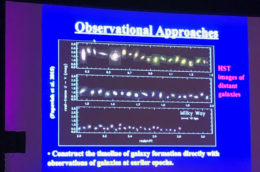
An (extremely blurry) example of how we can piece together a picture of how a single galaxy has evolved by observing similar galaxies at different points in cosmic time.
Dr. Shapley focused on galaxies with redshift between 1.5 and 3.5, since there was a lot going on in this time period: between a redshift of 2 and 3 was cosmic “high noon,” when the star-formation rate was at its maximum, and, coincidentally, the central black hole accretion rate was at a maximum as well. Observations show that galaxies at z~2 have more than an order of magnitude more star formation than galaxies today, are smaller (for a given mass), and have lots of gas inflows and outflows.
In order to study galaxies at these redshifts, Dr. Shapley uses optical spectroscopy. We can learn a lot from spectral lines: measuring the dust extinction, instantaneous star-forming rate, abundance of oxygen and other “metals”, and electron density, as well as determining whether the dominant ionization source is an active galactic nucleus or high-mass stars, and what kind of outflows are happening.
Of particular importance is the abundance of oxygen. If we measure the oxygen abundance in galaxies over the course of cosmic history, we can understand how galaxies become chemically enriched through stellar evolution and inflows, and chemically depleted through outflows.
Want to learn more about Dr. Shapley and her work? Check out her interview with Mia de los Reyes here!
Press Conference: Exoplanets, Flare Stars, and a Crab (by Susanna Kohler)
The first press conference of AAS 234 was a fun hodgepodge of topics, from exciting planet detections and updates on habitability to intriguing news about Sun-like stars.
In the first presentation, Lisa Prato (Lowell Observatory) and Christopher Johns-Krull (Rice University) jointly presented on the direct detection of CI Tau b, the youngest hot Jupiter to ever be observed directly. Hot Jupiters — gas-giant planets that orbit extremely close to their host stars — pose a particular challenge to detection: because they are so near to their stars, it’s quite difficult to separate the planet’s signal from its host’s, which is often hundreds of times brighter. But by combining 4 years of near-infrared spectroscopic observations of the CI Tau system, Johns-Krull, Prato, and collaborators were able to disentangle the carbon monoxide spectral lines of the planet CI Tau b from it’s star’s lines. This success is remarkable in such a young system; CI Tau is only around 2 million years old, and the star is still surrounded by the circumstellar disk of dust from which its planets formed. The system’s young age means that these observations of CI Tau b can provide unique constraints on models of how hot Jupiters like this one form — a long-standing question in exoplanet studies. Press release

Plot showing the narrowing of the habitable zone as a result of Schwieterman and collaborators’ work. The shaded region is the traditional habitable zone; blue indicates the part of this region that could support complex life. Click to enlarge. [Schwieterman et al. 2019]
Helen B. Warner Prize Lecture: Hunting for Dark Matter in the Early Universe (by Kerry Hensley)
Dr. Yacine Ali-Haïmoud (New York University) began his talk with an overview of dark matter. Dark matter doesn’t seem to emit, scatter, or absorb light, but does interact with luminous (aka “normal”) matter gravitationally. Dark matter clumps together and forms the filamentary structure along which galaxies form. Astronomers infer the presence of dark matter in our observations of large-scale structures like galaxy clusters as well as small-scale structures like dwarf galaxies, and it turns out there’s a lot of it — it’s more than five times more common than normal matter.
But what is dark matter? Well, that’s the million-dollar question! Dr. Ali-Haïmoud outlined a few options:
- A new kind of particle. We’ve already discovered a whole host of particles, but there’s plenty of parameter space left unexplored. If it turns out that dark matter isn’t completely “dark” — that is, that it interacts very, very weakly with photons — there’s a chance that we could detect it with any of the many ongoing or planned experiments like CDMS, EDELWEISS, or ZEPLIN.
- Macroscopic objects that are hard to detect. The frontrunners here are primordial black holes, which are thought to form within microseconds of the Big Bang when dense patches of the universe collapse directly into black holes.
- A combination of the two. There’s no reason that the “missing matter” has to come from just one source!
- Not a physical object at all. Instead, dark matter could be a modification of the laws of gravity that only shows up under certain conditions.
We can try to figure out what dark matter is made of by studying the very early universe through observations of tiny temperature fluctuations in the cosmic microwave background (CMB). The CMB radiation almost perfectly matches that of a blackbody with a temperature of 2.73 K, but it has tiny fluctuations — called anisotropies — smaller than one part in 10,000.
These anisotropies are sensitive to the nature of dark matter. For example, if dark matter is made up of primordial black holes, the photons generated when matter falling into those black holes heats up (similar to the emission we see from active galactic nuclei) could ionize the surrounding hydrogen, which would have an effect on the ionization history of the universe. This change would be imprinted upon the anisotropies in the CMB.
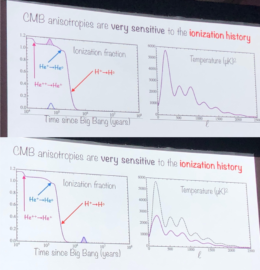
The power spectrum of the CMB is very sensitive to the ionization history of hydrogen and helium. This figure shows how the power spectrum changes if you add in a little extra ionization in the past.
Observations of the CMB indicate that primordial black holes can’t be the only source for dark matter if they have masses greater than 100 solar masses. The potential range of primordial black hole masses is huge, though — anywhere from 10-16 to 1010 solar masses. Twenty-six orders of magnitude! As far as our prospects of detecting these primordial black holes go, we have a chance of spotting them with the Laser Interferometer Gravitational-wave Observatory (LIGO) if they form in the correct mass range (a few to a few hundred solar masses) and form binaries. It’s still not clear whether or not these binaries, which would have formed very early in the universe’s history, would be able to survive the formation of large-scale structure in the universe. Clearly, there are lots of interesting questions left to be answered in our search for dark matter!
Learn more about Dr. Ali-Haïmoud in his interview with Kate Storey-Fisher here.
Press Conference: What’s New Under the Sun (by Susanna Kohler)
Though it’s been studied for centuries, our nearest star still poses a number of unsolved mysteries. This afternoon’s press conference introduced us to recent work addressing just a few of the open questions about the Sun.
Think the best images of our star all come from well-established, orbiting space telescopes? Think again! The High resolution Coronal Imager (Hi-C) is a telescope that was briefly launched to sub-orbital space on a sounding rocket; on each flight, it captured only a few minutes of observations of an active region of the Sun before returning to the ground. In that brief time, however, Hi-C took images with spectacular spatial and temporal resolution; just look at the video below (originally published on the Hi-C website) for a comparison of data from the orbiting Solar Dynamics Observatory AIA instrument to Hi-C observations!
In the first presentation of this press conference, Sanjiv Tiwari (Lockheed Martin Solar & Astrophysics Laboratory) presented discoveries made from data gathered during Hi-C’s second launch, just last year. The imager’s high-resolution observations revealed several different types of energy release — dot-like, loop-like, and jet-like brightenings — occurring on very small scales (perhaps a tenth of the diameter of Earth) within the core of an active region on the Sun. These energy releases appear to occur in the lower solar atmosphere in response to changes in the magnetic field on the Sun’s surface.
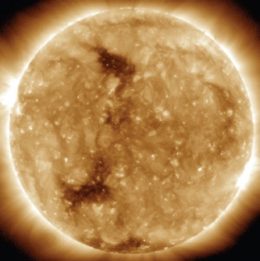
The small bright spots in this SDO image of the Sun represent coronal bright points, short-lived analogs of active regions. [NASA/SDO]
Karin Muglach (NASA Goddard Space Flight Center) and collaborators have found a potential solution to this problem: instead of trying to learn directly from large active regions, they propose studying their smaller-scale analogs, coronal bright points. The small size of these regions means that their lifetimes are correspondingly shorter — which allows us to observe them continuously from birth to death. When Muglach and collaborators watched four coronal bright points using imaging and magnetic-field monitoring from the Solar Dynamics Observatory, they found that the bright points appeared in the corona as bipolar magnetic flux emerged in the solar photosphere. The cancellation of that magnetic flux was related to eruptive events — jets — in the corona, immediately after which the intensity of the bright points faded.
Can we make any predictions about solar activity? According to Alexander G. Kosovichev (New Jersey Institute of Technology), the answer is yes. Kosovichev reported on how helioseismology — the study of oscillations on the Sun’s surface — has given us clues as to the origin of the 11-year solar activity cycle. By using helioseismology to map zonal flows in the Sun, Kosovichev and collaborators found that hydromagnetic waves are generated at the bottom of the solar convection zone (that’s 120,000 miles below the Sun’s surface) and at about 60° latitude. These waves slowly travel to the surface and toward the Sun’s equator, eventually regulating the appearance of sunspots — but they are slowed by magnetic fields. This connection, Kosovichev argues, allows us to use observations of polar magnetic field strength to predict the strength of the next solar maximum. Based on the currently observed polar magnetic fields, Kosovichev and collaborators expect that the next solar maximum will be even weaker than the solar maximum of our current solar activity cycle.
The benefits of helioseismology as a tool for studying the Sun are clear, but the data products of this study can be difficult to intuitively understand. A new tool called Sonification of Solar Harmonics (SoSH, for short) is now helping to make helioseismology a little more accessible. The Sun’s surface oscillates because plasma flows excite sound waves that then bounce around the Sun’s interior; the star is effectively a giant resonant cavity for low-frequency sound waves. In helioseismology, we measure these waves to learn about the solar interior, but we don’t actually listen to the sound waves themselves … that is, until now. Solar physicist Timothy Larson (Moberly Area Community College) worked with composer collaborators to develop the SoSH project, in which helioseismology data is filtered and frequency-shifted into a hearable range. So far, SoSH has sonified two full solar cycles of data from two instruments (MDI and HMI on the Solar Dynamics Observatory), and these sonifications are publicly available so that everyone can listen to the surface of the Sun sing. More information and sample sonifications are located here.
George Ellery Hale Prize Lecture: Observations about Observations of the Sun (by Kerry Hensley)
Dr. Philip Scherrer (Stanford University) gave a broad overview of advances in solar physics over the past four decades through the eyes of three observatories: the Wilcox Solar Observatory, ESA/NASA’s Solar and Heliospheric Observatory, and NASA’s Solar Dynamics Observatory. Those three observatories have contributed to thousands of research papers with more than 4,600 unique authors and 40 PhD theses!
The Wilcox Solar Observatory (WSO), a ground-based solar telescope, has been observing the Sun since 1975. The WSO is responsible for the longest-running set of measurements of the Sun’s mean magnetic field as well as low-resolution magnetograms, both of which are used to study and predict the solar activity cycle. WSO has been observing the Sun for four full sunspot cycles! (Or two 22-year magnetic cycles. Your choice.)
Next came the Solar and Heliospheric Observatory (SOHO), which was launched in 1995. While SOHO is still alive and well, the Michelson Doppler Imager (MDI), which was used to make measurements of the Sun’s magnetic field, hasn’t been used for science since 2011. SOHO/MDI brought about huge advances in the field of helioseismology — a method of studying the interior of the Sun through observations of waves on its surface — including allowing scientists to “look” through the Sun to “see” sunspots on the other side!
Finally, Dr. Scherrer showed some fantastic data and videos from Solar Dynamics Observatory (SDO), which was launched in 2010 and is still happily taking data from its vantage point in Earth orbit. One of SDO’s three instruments is the Heliospheric and Magnetic Imager (HMI), which makes measurements of the magnetic field of the Sun’s disk all at once. SDO has helped us better understand the large-scale motions of material within the Sun.
Throughout the talk, Dr. Scherrer shared some of his advice and lessons learned from his career. He shared his story of retracting a Nature paper claiming the discovery of the ever-elusive solar g-mode oscillations, which highlighted the importance of open discussion with collaborators and others, not rushing to publish science you aren’t confident in, and — perhaps most importantly — being mindful of your systematic errors!
Want to know more? Read his interview with Briley Lewis here.

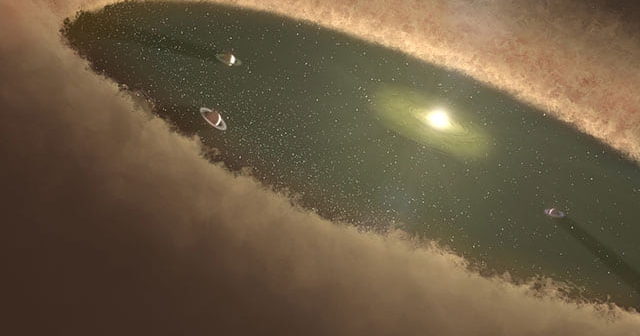
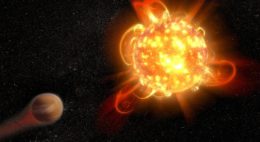
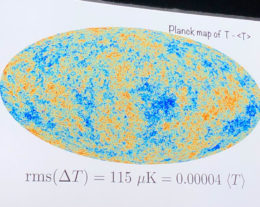

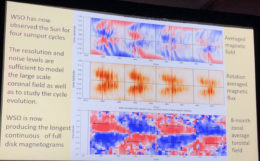
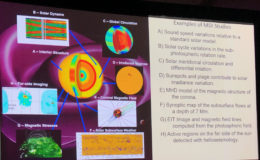

2 Comments
Pingback: Daily Study Log (2019-06-12) - Study Astrophysics
Pingback: Meet the AAS 234 Keynote Speakers: Philip Scherrer